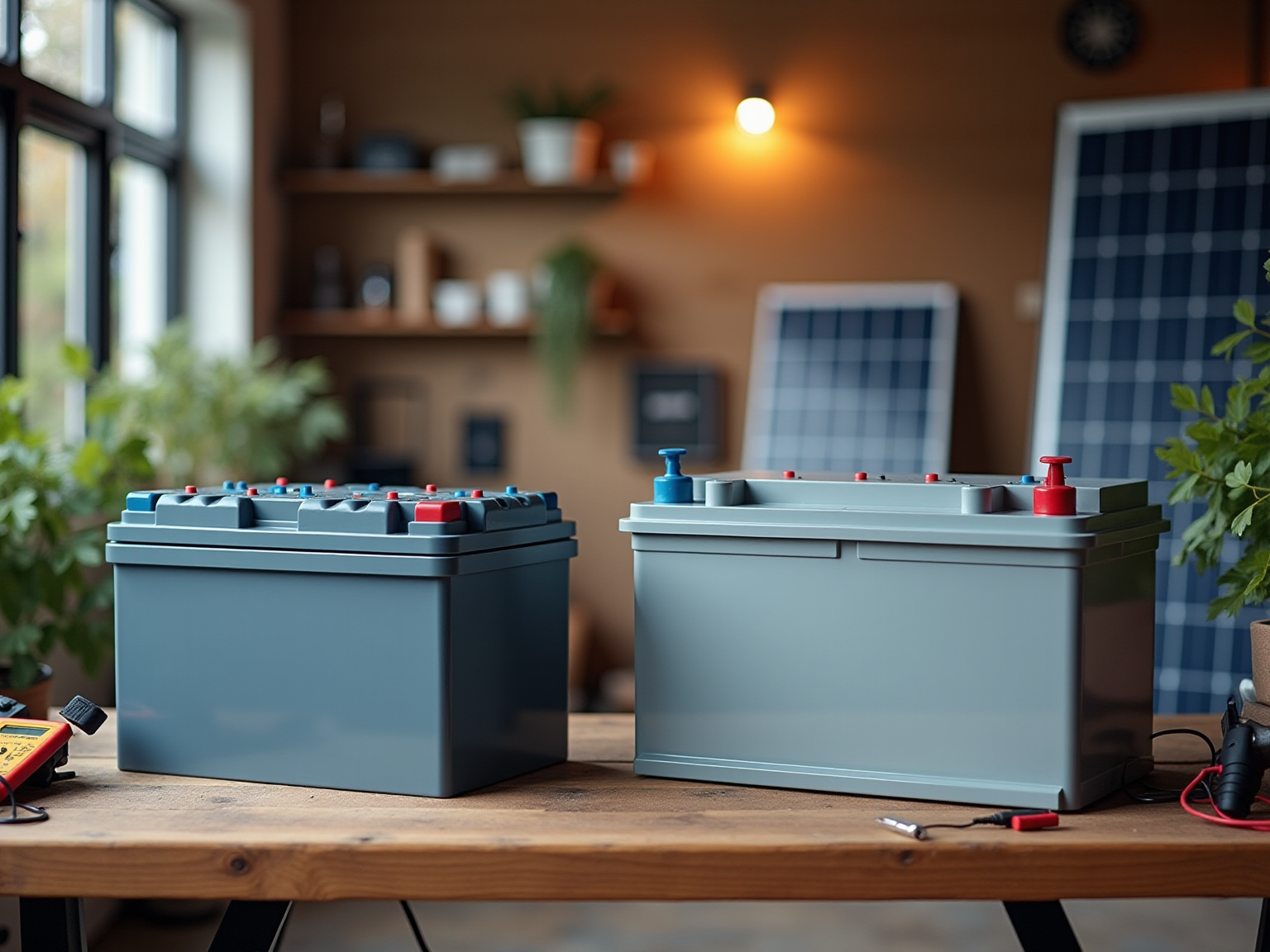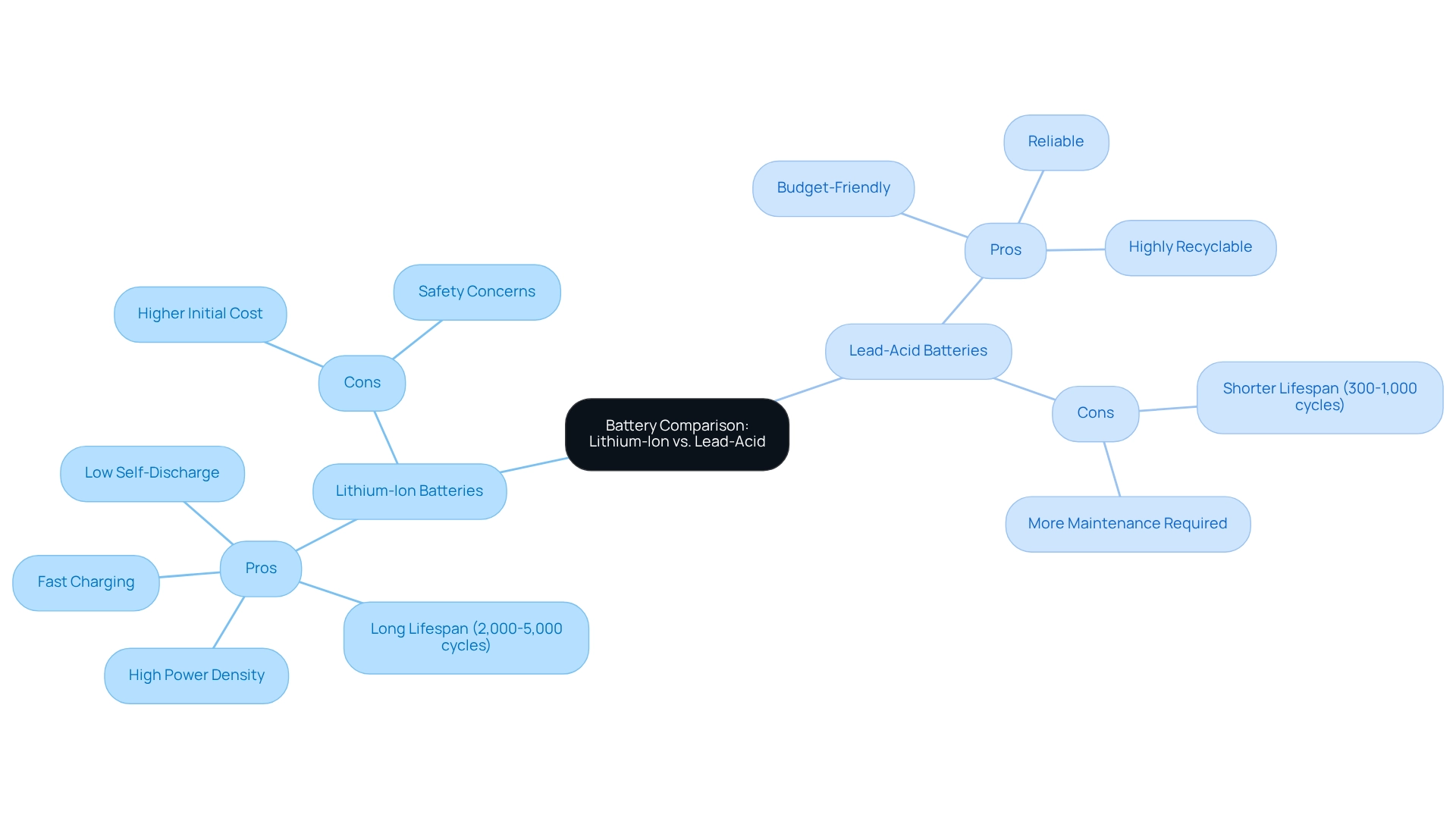Overview
In today’s world, many homeowners share concerns about rising energy bills and the search for sustainable solutions. When it comes to solar energy storage, choosing the right battery can feel overwhelming. Our article thoughtfully compares lithium-ion and lead-acid batteries, aiming to guide you toward the best option for your needs.
Lithium-ion batteries typically emerge as the superior choice. They offer high energy density, exceptional efficiency, and a longer lifespan, making them ideal for regular use in solar systems. Imagine the peace of mind that comes from knowing your energy storage is reliable and efficient.
However, we understand that not every situation calls for lithium-ion batteries. For specific applications, such as infrequent use or for those who are budget-conscious, lead-acid batteries can still be a viable option. It’s common to feel uncertain about which choice aligns best with your energy habits and financial situation.
As you evaluate your options, consider the benefits of energy independence that solar solutions can provide. Together, we can work towards a more sustainable future. If you have questions or need support in making the right decision for your home, please reach out. We’re here to help you navigate this journey with care and expertise.
Introduction
As the demand for sustainable energy solutions grows, we understand that many homeowners are increasingly faced with the crucial decision of selecting the right battery technology for their solar energy systems. You might be feeling overwhelmed by the choices available, and at the forefront of this choice are lithium-ion and lead-acid batteries, each offering distinct advantages and drawbacks.
- Lithium-ion batteries, renowned for their high energy density and extended lifespan, present an appealing option for those seeking efficiency and reliability.
- On the other hand, lead-acid batteries, with their lower initial cost and established recycling processes, remain a viable choice for specific applications.
This article delves into the unique characteristics of both battery types, exploring their suitability for various energy needs. Together, we can navigate the key considerations you must weigh to make informed decisions that align with your energy goals, ensuring you feel confident and supported in your journey towards energy independence.
Overview of Lithium-Ion and Lead-Acid Batteries
Overview of
As you navigate the complexities of energy storage, it’s essential to understand the differences between lithium-ion and lead-acid batteries. Lithium-ion batteries are advanced rechargeable options that utilize lithium ions in their electrochemical processes. They are celebrated for their high energy density, lightweight design, and extended cycle life, making them particularly suitable for those seeking the best solar battery for efficient energy storage in solar energy systems. In contrast, lead-based cells, one of the oldest rechargeable energy storage technologies, utilize lead dioxide and sponge lead as electrodes, with sulfuric acid acting as the electrolyte. While traditional accumulators may be heavier and bulkier, they often come with a lower initial expense and benefit from a well-established recycling system.
We understand that homeowners are often concerned about energy costs and the best solutions for their photovoltaic systems, especially when considering Tesla home chargers and governmental initiatives that encourage renewable adoption. Recent advancements in lithium-ion technology have further increased their attractiveness, with efficiencies surpassing 95% and lifespans that can be several times longer than those of lead-acid cells. This considerable durability strengthens their appropriateness for solar uses, especially as you search for a reliable and efficient power solution.
As the market evolves, lithium-ion cells are increasingly recognized for their exceptional reliability and efficiency, making them an appealing choice for sustainable power solutions. Jacob Marsh, a storage specialist, emphasizes that ‘in most instances, lithium-ion technology is superior to traditional alternatives because of its reliability and efficiency,’ reinforcing the case for lithium-ion adoption. However, it’s important to acknowledge that Sealed Lead-Acid accumulators are recommended for off-grid cabins or vacation homes due to their zero-maintenance nature, providing a balanced perspective on these technologies and their specific applications.
Pros and Cons Summary
-
Lithium-Ion Batteries
- Pros: High energy density, lightweight, long lifespan, high efficiency (>95%)
- Cons: Higher initial cost, requires specific recycling processes
-
Lead-Acid Batteries
- Pros: Lower initial cost, established recycling infrastructure
- Cons: Heavier, shorter lifespan, lower efficiency
In conclusion, while lithium-ion batteries offer significant advantages for solar energy systems, lead-acid batteries still have their place in specific applications, particularly for off-grid scenarios. Together, we can explore the best options for your energy needs, ensuring you feel supported every step of the way.
Pros and Cons of Lithium-Ion and Lead-Acid Batteries
As homeowners, we often find ourselves grappling with rising energy bills and the quest for sustainable solutions. When considering storage options for solar systems, it’s essential to weigh the pros and cons of lithium-ion versus traditional battery types.
- Lithium-ion cells stand out for their impressive power density and longevity, typically lasting between 2,000 to 5,000 cycles, along with faster charging times.
- They also boast a lower self-discharge rate, allowing them to hold their charge longer when not in use.
- However, we understand that the initial cost can be a concern, and there are safety considerations if not properly managed.
On the other hand, lead-acid batteries offer a more budget-friendly option and have a solid reputation for reliability.
- They are also highly recyclable, which is a significant benefit for our planet.
- Yet, it’s important to note that they have a shorter lifespan, ranging from 300 to 1,000 cycles, and require more maintenance.
Understanding these advantages and disadvantages is crucial for those of us looking to enhance our renewable energy systems with . Have you thought about how these options align with your energy goals?
Furthermore, staying informed about the latest market trends and consumer preferences can empower you to make the best choice for your needs.
Moreover, exploring solutions like Tesla home chargers and looking into government initiatives can significantly boost the efficiency and sustainability of your photovoltaic systems. Together, we can navigate this journey towards energy independence and create a brighter, more sustainable future for our homes and communities.
Suitability for Different Energy Needs: Lithium-Ion vs. Lead-Acid
Lithium-ion cells excel in situations that require regular cycling, making them particularly advantageous for homeowners who utilize renewable power daily. Their capacity to endure deep discharges and facilitate rapid charging allows for optimal power usage, ensuring that solar energy is harnessed effectively. In contrast, lead-acid cells may be more appropriate for infrequent uses or as backup power sources, where their lower initial cost becomes a significant factor. These cells are often employed in off-grid systems or for backup power in homes that do not necessitate constant power storage.
To identify the most suitable type of cell, it is essential to evaluate the specific power needs of your household. For instance, residences with high power consumption patterns may benefit more from lithium-ion solutions, which can handle frequent cycling and provide reliable performance. Conversely, for homeowners seeking a cost-effective option for occasional use, lead-acid batteries might be the preferred choice.
Pros and Cons of Battery Types:
- Lithium-Ion Batteries:
- Pros: High efficiency, deep discharge capability, rapid charging, long lifespan.
- Cons: Higher initial cost.
- Lead-Acid Batteries:
- Pros: Lower initial cost, suitable for infrequent use.
- Cons: Shorter lifespan, less efficient for daily cycling.
Recent studies indicate that homeowners optimizing with lithium-ion batteries experience enhanced efficiency and energy independence. For example, the Canadian Solar EP Cube, priced at $9,400 for 9.9 kWh with a 10-year warranty, represents a significant investment that can yield long-term benefits. Additionally, various incentives, such as a federal tax credit covering 30% of installation costs, further encourage the adoption of these advanced storage solutions. Engaging with various installers can provide valuable insights into whether investing in lithium-ion technology aligns with your power requirements and budget. As Catherine Lane, Written Content Manager at SolarReviews, emphasizes, making informed decisions about solar investments is crucial for maximizing benefits, especially in the context of integrating Tesla home chargers and solar panel functionality. Together, we can navigate these choices and work towards a more sustainable future.
Key Considerations for Choosing Between Lithium-Ion and Lead-Acid Batteries
When considering the choice between lithium-ion and traditional storage options, it’s essential to reflect on your unique needs and concerns as a homeowner. Factors such as budget, energy requirements, space availability, and maintenance needs play a crucial role in this decision.
While lithium-ion cells may come with a higher price tag, they offer extended lifetimes, reduced upkeep, and enhanced efficiency, making them a valuable long-term investment for many families. On the other hand, lead-acid cells may appeal to those on tighter budgets or those seeking a straightforward, low-maintenance solution.
We understand that the physical space available for installation can also influence your choice; lithium-ion cells are typically more compact, allowing for greater flexibility in your home.
By understanding these considerations, along with the economic benefits and specifications of each type, you can make a more informed decision about for your solar energy system. Together, let’s ensure optimal performance and energy independence in your home, paving the way for a brighter, more sustainable future.
Conclusion
Choosing the right battery technology for your solar energy system is a crucial step toward achieving energy independence. We understand that navigating these options can feel overwhelming. This article has explored the key differences between lithium-ion and lead-acid batteries, emphasizing their unique advantages and limitations.
Lithium-ion batteries shine with their high energy density, longer lifespan, and efficiency, making them perfect for daily energy use and frequent cycling. On the other hand, lead-acid batteries provide a more budget-friendly option, with an established recycling process, making them suitable for less frequent applications or as backup power sources.
Understanding the pros and cons of each battery type is essential for making an informed choice that aligns with your specific energy needs. While lithium-ion batteries may require a higher initial investment, their long-term benefits and lower maintenance needs can lead to significant savings over time. Conversely, lead-acid batteries can be a practical solution for those who prioritize upfront affordability and simplicity.
Ultimately, your decision should be guided by careful consideration of your energy consumption patterns, budget constraints, and installation requirements. By weighing these factors, you can confidently select the battery technology that best supports your solar energy goals. Together, we can ensure a more sustainable and efficient energy future, empowering you to take control of your energy journey.



